瞬时表达
- 格式:ppt
- 大小:2.46 MB
- 文档页数:39
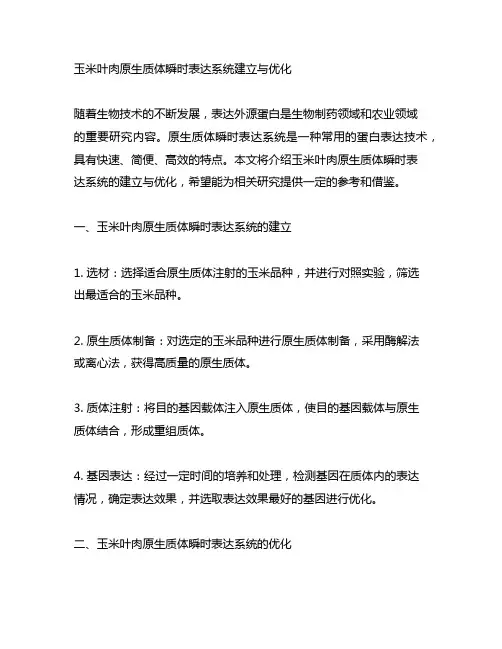
玉米叶肉原生质体瞬时表达系统建立与优化随着生物技术的不断发展,表达外源蛋白是生物制药领域和农业领域的重要研究内容。
原生质体瞬时表达系统是一种常用的蛋白表达技术,具有快速、简便、高效的特点。
本文将介绍玉米叶肉原生质体瞬时表达系统的建立与优化,希望能为相关研究提供一定的参考和借鉴。
一、玉米叶肉原生质体瞬时表达系统的建立1. 选材:选择适合原生质体注射的玉米品种,并进行对照实验,筛选出最适合的玉米品种。
2. 原生质体制备:对选定的玉米品种进行原生质体制备,采用酶解法或离心法,获得高质量的原生质体。
3. 质体注射:将目的基因载体注入原生质体,使目的基因载体与原生质体结合,形成重组质体。
4. 基因表达:经过一定时间的培养和处理,检测基因在质体内的表达情况,确定表达效果,并选取表达效果最好的基因进行优化。
二、玉米叶肉原生质体瞬时表达系统的优化1. 基因载体优化:对基因表达载体进行优化,如引入启动子、终止子、选择合适的启动子/终止子对基因进行调控。
2. 质体注射条件优化:探索最佳的质体注射条件,包括注射液的配制、渗透压、注射压力等因素。
3. 外源基因选择与优化:在选择外源基因时,考虑目的基因的大小、结构、稳定性等因素,进而优化外源基因的表达效果。
4. 生长调控剂的应用:在培养过程中添加适当的生长调控剂,如植物生长激素、营养液等,提高外源基因的表达。
5. 基因表达效果的检测与分析:通过蛋白质免疫印迹、荧光定量PCR等方法对外源基因的表达效果进行检测与分析,找出影响表达的关键环节。
三、玉米叶肉原生质体瞬时表达系统的应用前景1. 生物制药领域:玉米叶肉原生质体瞬时表达系统可用于大规模生产多肽类药物、抗体和疫苗等生物制药产品。
2. 农业领域:利用该系统表达抗病、抗虫、抗旱等相关基因,为农业生产提供技术支持。
3. 基因功能研究:该系统可用于外源基因的功能分析和相关途径研究。
总结:玉米叶肉原生质体瞬时表达系统的建立与优化对于蛋白表达和生物制药领域具有重要意义。
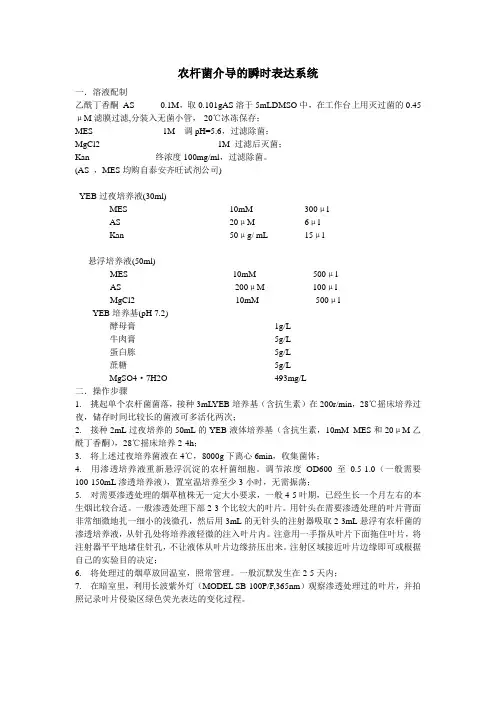
农杆菌介导的瞬时表达系统一.溶液配制乙酰丁香酮AS 0.1M,取0.101gAS溶于5mLDMSO中,在工作台上用灭过菌的0.45μM滤膜过滤,分装入无菌小管,-20℃冰冻保存;MES 1M 调pH=5.6,过滤除菌;MgCl2 1M 过滤后灭菌;Kan 终浓度100mg/ml,过滤除菌。
(AS ,MES均购自泰安齐旺试剂公司)YEB过夜培养液(30ml)MES AS Kan 10mM20μM50μg/ mL300μl6μl15μl悬浮培养液(50ml)MES 10mM 500μl AS 200μM 100μl MgCl2 10mM 500μl YEB培养基(pH 7.2)酵母膏牛肉膏蛋白胨蔗糖MgSO4·7H2O 1g/L5g/L5g/L5g/L 493mg/L二.操作步骤1. 挑起单个农杆菌菌落,接种3mL YEB培养基(含抗生素)在200r/min,28℃摇床培养过夜,储存时间比较长的菌液可多活化两次;2. 接种2mL过夜培养的50mL的YEB液体培养基(含抗生素,10mM MES和20μM乙酰丁香酮),28℃摇床培养2-4h;3. 将上述过夜培养菌液在4℃,8000g下离心6min,收集菌体;4. 用渗透培养液重新悬浮沉淀的农杆菌细胞。
调节浓度OD600至0.5-1.0(一般需要100-150mL渗透培养液),置室温培养至少3小时,无需振荡;5. 对需要渗透处理的烟草植株无一定大小要求,一般4-5叶期,已经生长一个月左右的本生烟比较合适。
一般渗透处理下部2-3个比较大的叶片。
用针头在需要渗透处理的叶片背面非常细微地扎一细小的浅微孔,然后用3mL的无针头的注射器吸取2-3mL悬浮有农杆菌的渗透培养液,从针孔处将培养液轻微的注入叶片内。
注意用一手指从叶片下面拖住叶片,将注射器平平地堵住针孔,不让液体从叶片边缘挤压出来。
注射区域接近叶片边缘即可或根据自己的实验目的决定;6. 将处理过的烟草放回温室,照常管理。
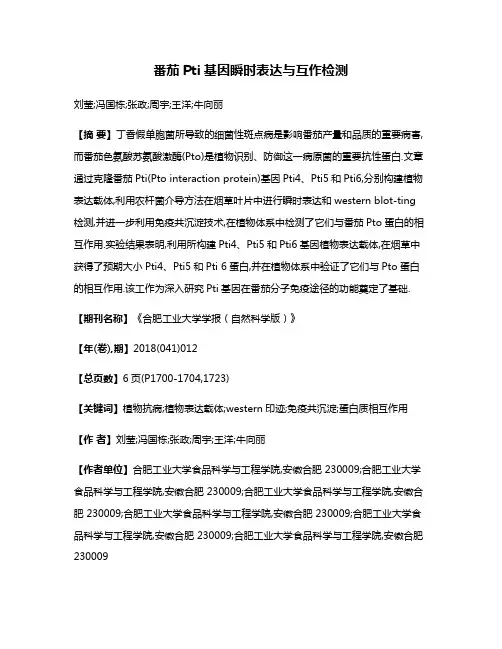
番茄Pti基因瞬时表达与互作检测刘莹;冯国栋;张政;周宇;王洋;牛向丽【摘要】丁香假单胞菌所导致的细菌性斑点病是影响番茄产量和品质的重要病害,而番茄色氨酸苏氨酸激酶(Pto)是植物识别、防御这一病原菌的重要抗性蛋白.文章通过克隆番茄Pti(Pto interaction protein)基因Pti4、Pti5和Pti6,分别构建植物表达载体,利用农杆菌介导方法在烟草叶片中进行瞬时表达和western blot-ting 检测,并进一步利用免疫共沉淀技术,在植物体系中检测了它们与番茄Pto蛋白的相互作用.实验结果表明,利用所构建Pti4、Pti5和Pti6基因植物表达载体,在烟草中获得了预期大小Pti4、Pti5和Pti 6蛋白,并在植物体系中验证了它们与Pto蛋白的相互作用.该工作为深入研究Pti基因在番茄分子免疫途径的功能奠定了基础.【期刊名称】《合肥工业大学学报(自然科学版)》【年(卷),期】2018(041)012【总页数】6页(P1700-1704,1723)【关键词】植物抗病;植物表达载体;western印迹;免疫共沉淀;蛋白质相互作用【作者】刘莹;冯国栋;张政;周宇;王洋;牛向丽【作者单位】合肥工业大学食品科学与工程学院,安徽合肥 230009;合肥工业大学食品科学与工程学院,安徽合肥 230009;合肥工业大学食品科学与工程学院,安徽合肥 230009;合肥工业大学食品科学与工程学院,安徽合肥 230009;合肥工业大学食品科学与工程学院,安徽合肥 230009;合肥工业大学食品科学与工程学院,安徽合肥230009【正文语种】中文【中图分类】Q943.2;S511.030 引言番茄是重要的经济作物,但每年均会因病虫害造成减产。
番茄细菌性斑点病是影响番茄产量和品质的重要病害,主要危害番茄叶、茎、花、叶柄和果实,感染时产生深褐色至黑色不规则斑点[1]。
自1933年首次报道以来,番茄细菌性斑点病在全球26个国家均有发现,我国也于1998年发现。
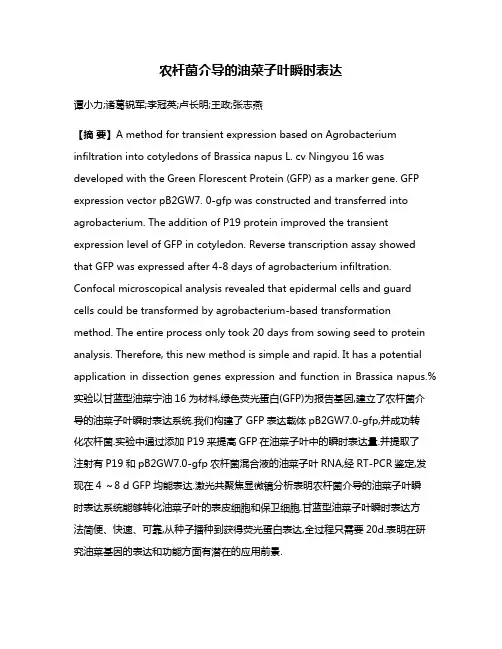
农杆菌介导的油菜子叶瞬时表达谭小力;诸葛锐军;李冠英;卢长明;王政;张志燕【摘要】A method for transient expression based on Agrobacterium infiltration into cotyledons of Brassica napus L. cv Ningyou 16 was developed with the Green Florescent Protein (GFP) as a marker gene. GFP expression vector pB2GW7. 0-gfp was constructed and transferred into agrobacterium. The addition of P19 protein improved the transient expression level of GFP in cotyledon. Reverse transcription assay showed that GFP was expressed after 4-8 days of agrobacterium infiltration. Confocal microscopical analysis revealed that epidermal cells and guard cells could be transformed by agrobacterium-based transformation method. The entire process only took 20 days from sowing seed to protein analysis. Therefore, this new method is simple and rapid. It has a potential application in dissection genes expression and function in Brassica napus.%实验以甘蓝型油菜宁油16为材料,绿色荧光蛋白(GFP)为报告基因,建立了农杆菌介导的油菜子叶瞬时表达系统.我们构建了GFP表达载体pB2GW7.0-gfp,并成功转化农杆菌.实验中通过添加P19来提高GFP在油菜子叶中的瞬时表达量.并提取了注射有P19和pB2GW7.0-gfp农杆菌混合液的油菜子叶RNA,经RT-PCR鉴定,发现在4 ~8 d GFP均能表达.激光共聚焦显微镜分析表明农杆菌介导的油菜子叶瞬时表达系统能够转化油菜子叶的表皮细胞和保卫细胞.甘蓝型油菜子叶瞬时表达方法简便、快速、可靠,从种子播种到获得荧光蛋白表达,全过程只需要20d.表明在研究油菜基因的表达和功能方面有潜在的应用前景.【期刊名称】《生物学杂志》【年(卷),期】2012(029)006【总页数】4页(P93-96)【关键词】甘蓝型油菜;子叶;农杆菌;瞬时表达【作者】谭小力;诸葛锐军;李冠英;卢长明;王政;张志燕【作者单位】江苏大学生命科学研究院,镇江212013;江苏大学生命科学研究院,镇江212013;江苏大学生命科学研究院,镇江212013;中国农业科学院油料作物研究所,武汉430062;江苏大学生命科学研究院,镇江212013;江苏大学生命科学研究院,镇江212013【正文语种】中文【中图分类】Q786油菜在世界各地广泛种植,在油料作物中其产量仅次于大豆与棕榈,位居第三。
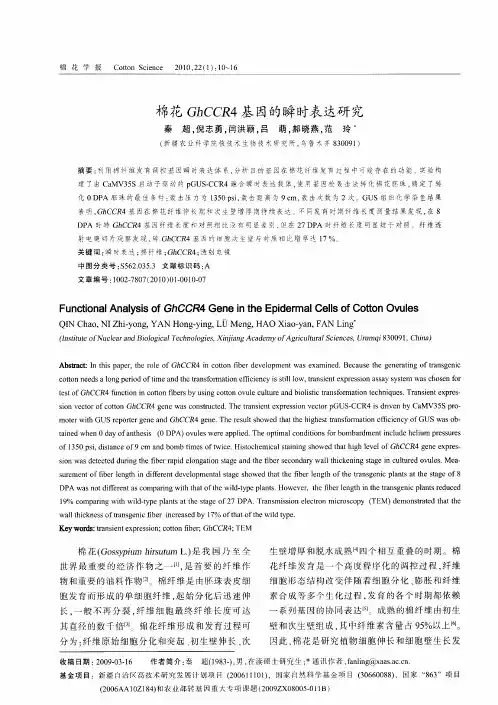

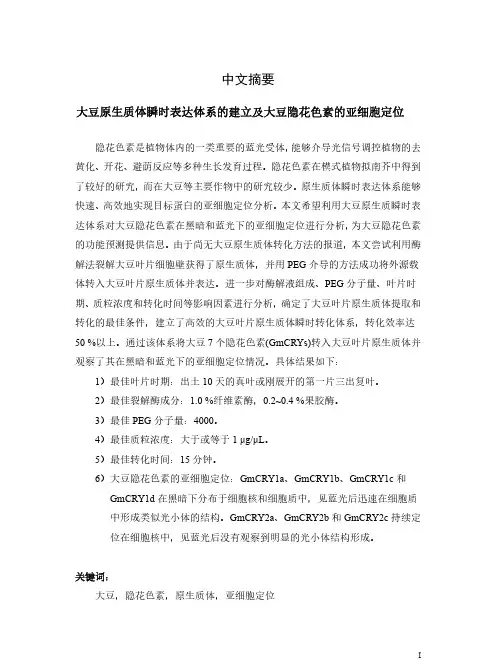
中文摘要大豆原生质体瞬时表达体系的建立及大豆隐花色素的亚细胞定位隐花色素是植物体内的一类重要的蓝光受体,能够介导光信号调控植物的去黄化、开花、避荫反应等多种生长发育过程。
隐花色素在模式植物拟南芥中得到了较好的研究,而在大豆等主要作物中的研究较少。
原生质体瞬时表达体系能够快速、高效地实现目标蛋白的亚细胞定位分析。
本文希望利用大豆原生质瞬时表达体系对大豆隐花色素在黑暗和蓝光下的亚细胞定位进行分析,为大豆隐花色素的功能预测提供信息。
由于尚无大豆原生质体转化方法的报道,本文尝试利用酶解法裂解大豆叶片细胞壁获得了原生质体,并用PEG介导的方法成功将外源载体转入大豆叶片原生质体并表达。
进一步对酶解液组成、PEG分子量、叶片时期、质粒浓度和转化时间等影响因素进行分析,确定了大豆叶片原生质体提取和转化的最佳条件,建立了高效的大豆叶片原生质体瞬时转化体系,转化效率达50 %以上。
通过该体系将大豆7个隐花色素(GmCRYs)转入大豆叶片原生质体并观察了其在黑暗和蓝光下的亚细胞定位情况。
具体结果如下:1)最佳叶片时期:出土10天的真叶或刚展开的第一片三出复叶。
2)最佳裂解酶成分:1.0 %纤维素酶,0.2~0.4 %果胶酶。
3)最佳PEG分子量:4000。
4)最佳质粒浓度:大于或等于1 μg/μL。
5)最佳转化时间:15分钟。
6)大豆隐花色素的亚细胞定位:GmCRY1a、GmCRY1b、GmCRY1c和GmCRY1d在黑暗下分布于细胞核和细胞质中,见蓝光后迅速在细胞质中形成类似光小体的结构。
GmCRY2a、GmCRY2b和GmCRY2c持续定位在细胞核中,见蓝光后没有观察到明显的光小体结构形成。
关键词:大豆,隐花色素,原生质体,亚细胞定位AbstractEstablishment of the Protoplasts Transient Gene Expression System and the Subcellular Localization of Cryptochromes in SoybeanCryptochromes are a kind of blue light receptors which mediate the regulation of growth and development in plants by mediating various light responses including de-etiolation of seedlings, flowering time, shade avoidance response, and so on. Many secret of cryptochromes have been revealed in Arabidopsis, however, it is little known about the cryptochromes in soybean. The transient gene expression system using protoplasts has provided a rapid and highly efficient way for the subcellular localization.We want to investigate the subcellular localization of soybean cryptochromes in darkness and under blue light using soybean protoplasts and provide information on the function of cryptochromes in soybean. There is little report about soybean protoplasts transformation, however, we have successfully isolated the protoplasts by enzymatic digestion of mesophyll cells from soybean and transformed the expression vector to the protoplasts for subsequent transient expression, which is mediated by PEG. Moreover, we optimized the main influencing factors including the suitable enzyme digestion system, the molecular weight of PEG, the different growth stages of leaves, the plasmids concentrations and the incubation time, and developed an efficient transient gene expression system using soybean mesophyll protoplasts whose transformation efficiency is over 50 %. We studied the subcellular localization of cryptochromes in soybean in darkness and under blue light using this system. The main results are showed as follows:1)The best growth stages of leaves: the 10-day-old unifoliolates afteremergence and the first trifoliolates which is just unfolding.2)The best enzyme digestion system: Celluase 1.0 %, Pectolase Y-230.2~0.4 %.3)The best molecular weight of PEG: 4000.4)The best plasmids concentrations: greater than or equal to 1 μg/μL.5)The best incubation time: 15 min.6)The subcellular localization of cryptochromes in soybean: The GmCRY1a、GmCRY1b、GmCRY1c and GmCRY1d are located in the nucleus and thecytoplasm of cells in darkness,and formed photobody-like structure incytoplasm while transferred to blue light. The GmCRY2a、GmCRY2b andGmCRY2c are always present in the nucleus, and it is difficult to observe thephotobody formation of the GmCRY2a、GmCRY2b and GmCRY2c.Keywords:Soybean, Cryptochromes, Protoplast, Subcellular localization中英文对照表英文缩写英文全称中文CRY Cryptochrome 隐花色素PHY Phytochrome 光敏色素Phot Phototropin 向光素PEG polyethylene glycol 聚乙二醇FAD Flavin Adenine Dinucleotide 黄素腺嘌呤二核苷酸SPA Suppressor of Phytochrome A 光敏色素A抑制子COP Constitutive Photomorphogenic 持续性光形态建成CIB cryptochrome-interactingbasic-helix-loop-helix 隐花色素互作bHLH转录因子BIC Blue-light Inhibitor of Cryptochromes 隐花色素的蓝光抑制子YFP Yellow Fluorescent Protein 黄色荧光蛋白DAE Days After Emergence 出土后天数目录第1章 绪论 (1)1.1 隐花色素 (1)1.1.1 隐花色素的发现 (1)1.1.2 隐花色素的结构 (2)1.1.3 隐花色素的功能 (3)1.1.4 植物隐花色素的光激活及光信号传递机制 (8)1.2 植物原生质体的基因瞬时表达体系 (12)1.2.1 原生质体的分离 (12)1.2.2 原生质体的转化 (13)1.2.3 原生质体的培养 (14)1.3 研究目的与意义 (15)第2章 材料与方法 (16)2.1 试验材料 (16)2.2 主要试剂的配制 (17)2.3 大豆原生质体瞬时表达体系的建立 (19)2.3.1 pA7-YFP质粒的扩繁与提取 (19)2.3.2 大豆叶片原生质体的提取 (22)2.3.3 大豆叶片原生质体的转化 (23)2.4 大豆隐花色素的亚细胞定位观察 (26)2.4.1 大豆隐花色素进化树及蛋白序列分析 (26)2.4.2 pA7-GmCRYs-YFP载体的构建 (26)2.4.3 pA7-GmCRYs-YFP载体转化大豆叶片原生质体 (29)2.4.4 大豆隐花色素亚细胞定位的观察 (29)第3章 结果与分析 (30)3.1 大豆原生质体的提取与转化 (30)3.1.1 大豆叶片裂解酶浓度的选择 (30)3.1.2 PEG分子量对大豆叶片原生质转化的影响 (31)3.1.3 叶片生长时期对大豆叶片原生质体化的影响 (31)3.1.4 质粒浓度对大豆叶片原生质转化的影响 (32)3.1.5 PEG处理时间对大豆叶片原生质转化的影响 (33)3.2 大豆隐花色素色素的序列分析及亚细胞定位 (33)3.2.1 隐花色素的蛋白序列比对和进化树分析 (33)3.2.2 大豆隐花色素(GmCRYs)的亚细胞定位 (35)第4章 讨论 (39)4.1 大豆叶片原生质体的转化 (39)4.2 大豆隐花色素的亚细胞定位 (40)第5章 结论 (43)参考文献 (44)作者简介 (53)致 谢 (54)第1章绪论1.1 隐花色素植物不能像动物一样移动,面对时刻变化的周边环境,它们只能通过调控自身生长来适应环境。
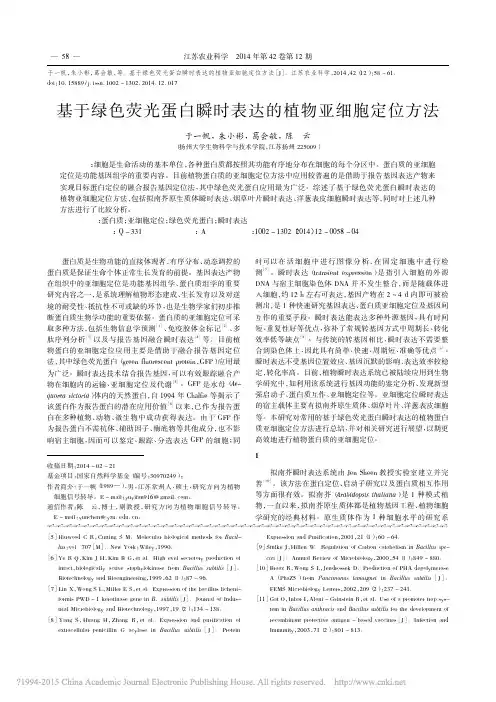

用玉米叶肉原生质体进行瞬时表达实验步骤用玉米叶肉原生质体进行瞬时表达实验(peg转)一、生长条件将玉米种子浸泡过夜,然后移到蛭石和营养土各半的培养基中光照生长3天(地上部分大约1cm左右),再移到黑暗条件下生长直到第二片叶的长度比第一片叶长10-15cm,这需要在25℃条件下生长10-11天。
只浇水不用施肥。
为了防止细菌生长,可往培养基中加入50-100g/ml的amp。
黄化叶片的原生质体可用于实验,茎和根也可以用,但尽量避免用绿色的叶片。
二、原生质体分离切下第二片叶子的中部(6-8厘米)。
将20片叶子叠在一起,轻轻按压,切成0.5毫米的条状,不要损坏叶子。
用95%酒精清洁刀片。
1克含有5×106原生质体,可进行50次反应。
在250ml的容器中放入10-20ml的酶液,放入切好的叶片,抽真空30min,40rpm轻摇,继续消化3-4hr。
通常消化时间往往在黑暗条件下延长至16-18h。
在显微镜下检测原生质体的完整性,玉米叶肉原生质体的大小为25-35um。
80rpm继续震荡5min,使原生质体完全释放。
三、纯化1.将消化后的原生质体过滤到带有74微米滤网的10毫升离心管中。
原生质体用枪转移,枪头需要切除。
2、4℃,100xg离心2min,吸掉上清(需剪枪头),将原生质体迅速轻轻弹起,然后沿离心管壁加入w5buffer,使原生质体悬浮(加入缓冲液的量取决于原生质体,通常为1-5ml)。
3.重复步骤2一次。
4、4℃,100xg离心1min,吸掉上清,将原生质体迅速轻轻弹起,然后沿管壁加入w5buffer,使原生质体悬浮,冰上放置30min。
5、将10ul1ug/ul的质粒加到干净的2ml 离心管中。
6.吸取原生质体上方的上清液,沿管壁添加1mg悬浮原生质体。
7.4℃100xg离心1min。
8、吸掉上清,再加入mmg重新悬浮原生质体,用量考虑原生质体的浓度,保持在104-5个/ml。
9、检测原生质体的完整性。
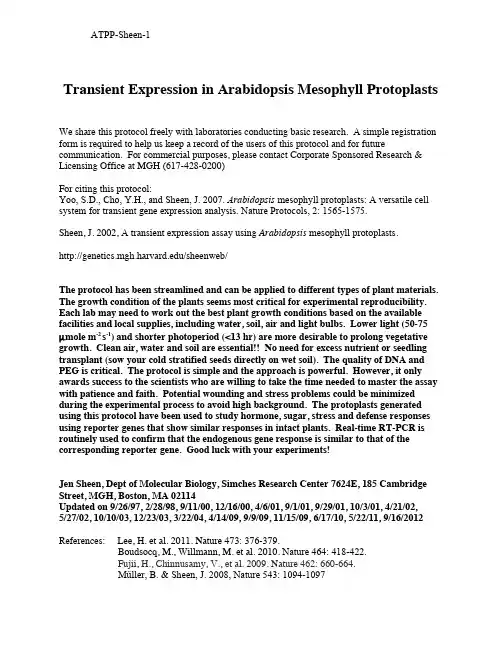
Transient Expression in Arabidopsis Mesophyll Protoplasts We share this protocol freely with laboratories conducting basic research. A simple registration form is required to help us keep a record of the users of this protocol and for future communication. For commercial purposes, please contact Corporate Sponsored Research & Licensing Office at MGH (617-428-0200)For citing this protocol:Yoo, S.D., Cho, Y.H., and Sheen, J. 2007. Arabidopsis mesophyll protoplasts: A versatile cell system for transient gene expression analysis. Nature Protocols, 2: 1565-1575.Sheen, J. 2002, A transient expression assay using Arabidopsis mesophyll protoplasts./sheenweb/The protocol has been streamlined and can be applied to different types of plant materials. The growth condition of the plants seems most critical for experimental reproducibility. Each lab may need to work out the best plant growth conditions based on the available facilities and local supplies, including water, soil, air and light bulbs. Lower light (50-75µmole m-2 s-1) and shorter photoperiod (<13 hr) are more desirable to prolong vegetative growth. Clean air, water and soil are essential!! No need for excess nutrient or seedling transplant (sow your cold stratified seeds directly on wet soil). The quality of DNA and PEG is critical. The protocol is simple and the approach is powerful. However, it only awards success to the scientists who are willing to take the time needed to master the assay with patience and faith. Potential wounding and stress problems could be minimized during the experimental process to avoid high background. The protoplasts generated using this protocol have been used to study hormone, sugar, stress and defense responses using reporter genes that show similar responses in intact plants. Real-time RT-PCR is routinely used to confirm that the endogenous gene response is similar to that of the corresponding reporter gene. Good luck with your experiments!Jen Sheen, Dept of Molecular Biology, Simches Research Center 7624E, 185 Cambridge Street, MGH, Boston, MA 02114Updated on 9/26/97, 2/28/98, 9/11/00, 12/16/00, 4/6/01, 9/1/01, 9/29/01, 10/3/01, 4/21/02,5/27/02, 10/10/03, 12/23/03, 3/22/04, 4/14/09, 9/9/09, 11/15/09, 6/17/10, 5/22/11, 9/16/2012 References: Lee, H. et al. 2011. Nature 473: 376-379.Boudsocq, M., Willmann, M. et al. 2010. Nature 464: 418-422.Fujii, H., Chinnusamy, V., et al. 2009. Nature 462: 660-664.Müller, B. & Sheen, J. 2008, Nature 543: 1094-1097Shan, L., He, P. et al. 2008, Cell Host & Microbe 4: 17-27Yoo, S.D. et al. 2008, Nature 451: 789-795Baena-González, E., Rolland, F. et al. 2007, Nature 448: 938-942Yoo, S.D., Cho, Y.H., and Sheen, J. 2007. Nature Protocols 2: 1565-1575He, P., Shan, L. et al. 2006. Cell 125: 563-575Yanagisawa, S., Yoo, S.D., & Sheen, J. 2003, Nature 425: 521-525Asai, T., Tena, G. et al. 2002, Nature 415: 977-983Sheen, J. 2001, Plant Physiol 127:1466-1475Hwang, I. & Sheen, J. 2001, Nature 413: 383-389Kovtun, Y. et al., 2000, PNAS 97: 2940-2945Kovtun, Y. et al., 1998, Nature 395: 716-720.Yanagisawa, S. & Sheen, J. 1998, Plant Cell 10: 75-89.Sheen, J. PNAS 98: 975-980.Chiu, W.L. et al., 1996, Curr Biol 6: 325-330.Sheen, J. 1996, Science 274: 1900-1902.Jang, J.C. & Sheen, J. 1994, Plant Cell 6:1665-1679.Abel, S. & Theologis, S. 1994, Plant J 5: 421-427Sheen, J. 1993. EMBO J. 12: 3497-3505.Schäffner, A.R. & Sheen, J. 1992. Plant J. 2: 221-232.Schäffner, A.R. & Sheen, J. 1991. Plant Cell 3: 997-1012.Sheen, J. 1991. Plant Cell. 3: 225-245.Sheen, J. 1990. Plant Cell 2: 1027-1038.Damm, B., Schmidt, R., and Willmitzer, L. 1989, MGG 217: 6-12Negrutiu, I. et al., 1987, Plant Mol Biol 8: 363-373A Transient Expression Assay Using Arabidopsis Mesophyll ProtoplastsA. Protoplast IsolationPlant Materials:BE plants grown on the B5 mediumGreenhouse-grown BE, Col, L er and C24 plants and most mutants are fineUse well expanded leaves from 3-4 weeks old plants (the second and/or third/fourth pair, 1-2 cm) before flowering. It’s OK to use plants that are 1-3 weeks old but more plants are needed. Suggested plant growth condition: low light (50-75 µmole m-2 s-1), short photoperiod (12-13h), 22-25o C, water as needed (no need to add nutrient solution when grown in soil), good/fresh air flow (very important). Please check the local water and soil quality or contamination. Protoplast Isolation Procedure:Cut 0.5-1 mm leaf strips with fresh razor blades without wounding. This is perhaps the most tedious part for most people. Piling leaves for more efficient cutting is optional. However, I consider it easier and more efficient than peeling the lower epidermis of the leaves one by one. It takes some practice. Some labs use a tape to peel the epidermal layer and it seems to work well. A large preparation yields around 107 protoplasts/g fresh weight (about 100 to 150 leaves digested in 40-60 ml of enzyme solution). For a practice and most experiments, 10-20 leavesdigested in 5-10 ml cellulase/macerozyme solution will give 0.5 -1 x 106 protoplasts that are enough for more than 50-100 samples (1-2 x 104 protoplasts per sample). Please note that it is not necessary to use 106 protoplasts per sample for gene expression analysis as commonly recommended in other protoplast protocols. The experiments can be easily scaled up or down as long as the recommended DNA/protoplast ratio is followed (see below). To observe subcellular localization or protein-protein interactions by BiFC of tagged proteins, 103 -104 cells are more than enough. For promoter analysis, 100-1000 cells are sufficient, depending on the promoter strength and reporter gene used. For protein expression and co-immunoprecipitation, 104 -105 protoplasts are needed. Around 105 protoplasts are needed for RNA isolation.Submerge the leaf strips in enzyme solution in a Petri dish, and put it into to a vacuum desiccator. Apply vacuum infiltration for 5-30 min. Continue the digestion for another 60 to 90 min with gentle shaking (40 rpm on a platform shaker) or digest up to 3 h without shaking in the dark (depending on the experimental goals and desirable responses). This step needs to be tested empirically for your own assay. For soil-grown plants, do not digest the leaves for overnight. The usual prolonged incubation of leaves for 12-18 h in the dark for protoplast isolation is stressful and might eliminate physiological responses of leaf cells. However, the stress might be potentially important for the dedifferentiation and regeneration processes when sterile plants grown on culture medium are used. The enzyme solution should turn green which indicates the release of round protoplasts (check under microscope, the size of Arabidopsis mesophyll protoplasts is around 15 to 50 µm). Release the protoplasts by shaking at 80 rpm for 1-5 min. No intention is made to release protoplasts 100%. Be gentle with the protoplasts!Filter the enzyme solution containing protoplasts with a 35-75 µm nylon mesh. Spin at 100x g to pellet the protoplasts in a round-bottomed tube for 1-2 min (speed 3-4 with an IEC clinical centrifuge or <1000 rpm on a bench top centrifuge). Higher speed or the addition of CaCl2 (50 mM) may be used if the protoplast recovery is poor. The pelleted protoplasts should be resuspended easily by gentle shaking. Wash protoplasts once in cold washing/incubation (WI) solution for electroporation or W5 solution for PEG transfection, and resuspend protoplasts in the same solution at 2 x 105/ml. Keep the protoplasts on ice (30 min) in WI or W5 solution unless cold responses will be studied. For some experiments, protoplasts could be kept at room temperature before use (Please test). Although the protoplasts can be kept on ice for at least 24 h, freshly prepared protoplasts should be used for the study of regulated gene expression, signal transduction, and protein trafficking, processing and localization. We use these protoplasts to study leaf cell responses to sugars, auxin, ABA, cytokinin, ethylene, GA, heat, cold, EtOH,H2O2, calcium, elicitors and peptides. The responses in protoplasts are similar to those observed in intact plant leaves. These protoplasts are also a good source for the isolation of intact nuclei and chloroplasts. If W5 solution is used, spin down protoplasts (speed 3 for 1 min) and resuspend in MMg solution (2 x 105/ml) before PEG transfection. For FACS (fluorescence-activated cell sorting) with protoplasts, it is better to use W5 instead of WI because the low solubility of mannitol.B. PEG TransfectionAll steps are carried out at 23o CAdd 10 µl DNA (10-20 µg of plasmid DNA of 5 kb in size. Please test down to 2-4 µg)Add 100 µl protopolasts to a microfuge tube (2 x 104 protoplasts), mix wellAdd 110 µl of PEG/Ca solution, mix well (handle 6 samples each time)Incubate at 23o C for 3-30 min (please test)Dilute with 0.44 ml W5 solution, mix wellSpin at speed 3 (1 Krpm) in a Clinical centrifuge for 1 min, remove PEGResuspend protoplasts gently, dilute in 100 µl, add to 1 ml WI or W5 (6-well plates)This procedure can be scaled up or down depending on the experimental needsDue to the “transient” nature of the experiments, it is not necessary to perform experiments under sterile conditions. The addition of Amp (50 µg/ml) can prevent bacterial growth if it is necessary.The system is most suitable for the study of early events in diverse signal transduction pathways, gene regulation, and cell death (Asai et al., Plant Cell 12:1823-1835, 2000).The use of carrier DNA is unnecessary.Use 6-well tissue culture dishes (Falcon 3046) for protoplast incubation. We now also use 12-well (0.5 ml) or 24-well (0.25 ml) plates for large experiments (with 50-200 samples).The dish can be coated with 5% calf serum for 1 sec before use to prevent the sticking of the protoplasts to the plastic.The protoplast incubation time is 2-6 h for RNA analysis and 2-16 h for enzyme activity analysis and protein labeling or immunoblot analysis. About 100-1000 protoplasts are sufficient for reporter enzyme assays, 104-105 protoplasts are required for protein labeling & immunoprecipitation or immunoblot analysis, and 105-6 protoplasts for RNA analysis.These protoplasts can be cultured for cell wall regeneration and cell cycle initiation with proper medium and plant hormones (Damm, B. et al., MGG 217: 6-12. 1989).PEG transformation efficiency is 50-90% based on GFP expression. If your protoplasts are healthy (from proper leaf materials. Please test), most protoplasts remain intact. Electroporation efficiency is 10-30% (depending on plant conditions). More than 50% protopolasts can be killed by electroporation. However conditions could be adjusted to reduce killing (Please test). Protoplasts produced from different plant species and tissues or growth conditions may show different electroporation tolerance. For instance, etiolated or greening maize mesophyll protoplasts tolerate electroporation extremely well.Harvest protoplasts by centrifugation at 100x g for 1-2 min. Remove the supernatant. Freeze and store samples at -80o C until ready for analysis.Add 100 µl of hypotonic buffer (10 mM Tris, pH 8 and 2 mM MgCl2) or LUC lysis buffer (Promega), vortex vigorously for 2 sec to lyse the protoplasts. (The LUC lysis buffer contains 1% Triton X-100. Thus, gentle vortex is sufficient.)A fast and economical xylenes extraction protocol is used for CAT assay (Seed and Sheen, 1988, Gene 67, 271-277; Sheen, in the supplement 9.6.5 of the Current Protocols in MolecularBiology, Ausubel eds). Heating the cell extract at 65o C for 10 min in the presence of 5 mM EDTA might eliminate potential inhibitors for CAT assay (It seems to be useful for Columbia but not C24). We got good CAT activity without heat treatment. We use a Promega kit for LUC assay with a luminometer or a plate reader. The GUS assay has been described by Jefferson, R. (Add the cell extract into 10-100 µl of 1 mM MUG, incubate for 30-90 min at 37o C, add 0.2-0.9 ml 0.2 M Na2CO3 to stop the reaction, and measure the fluorescence of MU).C. SolutionsEnzyme solution1-1.5 % cellulase R10 (RS is too strong) (0.1-0.15 g /10 ml)0.2-0.4% macerozyme R10 (Yakult Honsha, Tokyo, Japan) (0.02-0.04 g/10 ml)0.4 M mannitol (0.8M mannitol stock)20 mM KCl (2M KCl stock)20 mM MES, pH 5.7 (0.2 M stock)Heat the enzyme solution at 55o C for 10 min (to inactivate proteases and enhance enzyme solubility) and cool it to room temperature before adding10 mM CaCl2 (1 M stock)5 mM β-mercaptoethanol (optional)0.1% BSA (Sigma A-6793 or A-7906) (optional) (10% stock, sterile)The enzyme solution is light brown but clear (passed through a 0.45 µm filter).PEG solution (40%, v/v)4 g PEG4000(Fluka, #81240 can be purchased from Sigma since 2009) **VERY Important!!3 ml H2O2.5 ml 0.8 M mannitol1 ml 1M Ca(NO3)2 or CaCl2 (no difference)Washing and incubation solution (WI)0.5 M mannitol,4 mM MES, pH 5.720 mM KClW5 solution154 mM NaCl (5M stock)125 mM CaCl25 mM KCl2 mM MES (pH 5.7) (no glucose since we use glucose as a signal)MMg solution0.4 M mannitol15 mM MgCl2 (1M stock)4 mM MES (pH 5.7)D. Electroporation40 ug plasmid DNA4-6 x 104 protoplasts/300 ul of 0.3 M mannitol/4 mM MES, pH 5.7/150 mM KCl300-400 V/cm5 msec, 200 uF, 1-2 pulsesE. Enzymes and nylon filtersThere is no "catalogo number"Here is what we ordered.They call it "DESCRIPTION OF GOODS"CELLULASE"ONOZUKA"R-10 (100g) (for Arabidopsis and dicot leaves) CELLULASE"ONOZUKA"RS (100g) (for maize and monocot leaves)MACEROZYME R-10 (100g) (for both dicot and monocot leaves)The Cellulase and macerozyme are purchased fromYakult Pharmaceutical IND. CO., LTD.Shinbashi MCV Building5-13-5 Shinbashi Minato-KuTokyo, JapanTel 03-5470-8911 (international call 81-3-5470-8911)Fax 03-5470-8921 (international fax 81-3-5470-8921)The purchasing process can take up to a few weeks.You can pay for express mail delivery, which takes 3-7 days.You can send e-mail (yakultph@) or call (81-3-5470-8911) to make an order request. If you don’t speak Japanese (I do not), please be very patient and insist on asking for someone who can speak English with you to make the order. Speak slowly and politely is the key!! HIROTO WATANABEDEPUTY GENERAL MANAGERorHaruhiko KanaiDeputy Manager of Technical Department(Note that the name of the manager may change over the years)Yakult Pharmaceutical Ind Co LTD5-13-5 Shinbashi Minato-Ku Tokyo Japan 105-0004FAX 81-3-5470-8921Email yakultph@URL: hppt://www.yakult.co.jp/ypi/You may order the re-packaged Yakult enzymes from other companies (Google search), but they are in smaller package (10g) and much more expensive.The Nylon filters (35-75 µm) can be purchased from Carolina Biological SuppliesF. Troubleshooting TipsA list of factors that can be systematically tested if problems occur.Arabidopsis accessionsArabidopsis growth condition is accession-dependent (e.g., flowering time differences). Since leaves before bolting are used, Col and L er plants will perform better under shorter photoperiod (10-12 h) and lower light.Seed quality (age, growth condition)Plates (B5 medium)SoilGrowth condition (temperature, humidity, light intensity, photoperiod, water, nutrient) Plants, Enzymes & DNALeaf ageLeaf development & morphologyEnzyme solution (enzyme quality, heat treatment)Digestion timeReporter genesPEGMannitolW5Plasmid DNA quality (We use the more economical CsCl gradient for plasmid DNApurification. Make sure you remove the salt)Protoplast/DNA ratioProtoplast qualityResting timeResponse timeIncubation time (for gene expression or protein labeling)Culture platesExperiment size/duration (Very ambitious experiments tend to fail more often)Stimuli application (timing, concentration, duration, etc.). We always test themextensively to cover a broad range of signal dosage or concentrations when a new signal is applied for the first time.Arabidopsis plants are very sensitive to any kind of environmental changes. So, be sensitive to your plants’ needs and behaviors.。
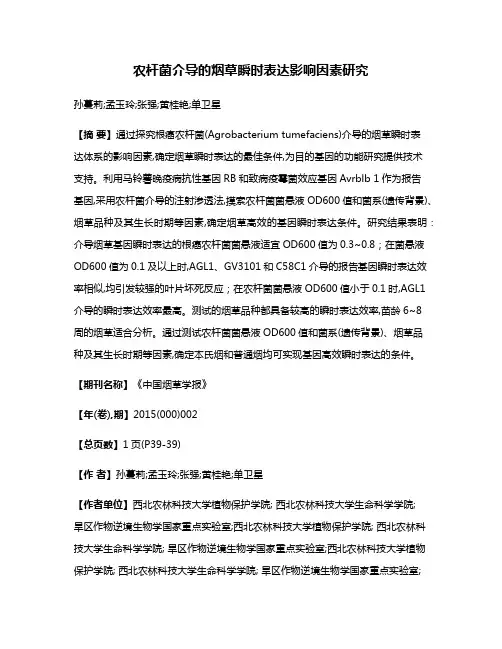
农杆菌介导的烟草瞬时表达影响因素研究孙蔓莉;孟玉玲;张强;黄桂艳;单卫星【摘要】通过探究根癌农杆菌(Agrobacterium tumefaciens)介导的烟草瞬时表达体系的影响因素,确定烟草瞬时表达的最佳条件,为目的基因的功能研究提供技术支持。
利用马铃薯晚疫病抗性基因RB和致病疫霉菌效应基因Avrblb 1作为报告基因,采用农杆菌介导的注射渗透法,摸索农杆菌菌悬液OD600值和菌系(遗传背景)、烟草品种及其生长时期等因素,确定烟草高效的基因瞬时表达条件。
研究结果表明:介导烟草基因瞬时表达的根癌农杆菌菌悬液适宜OD600值为0.3~0.8;在菌悬液OD600值为0.1及以上时,AGL1、GV3101和C58C1介导的报告基因瞬时表达效率相似,均引发较强的叶片坏死反应;在农杆菌菌悬液OD600值小于0.1时,AGL1介导的瞬时表达效率最高。
测试的烟草品种都具备较高的瞬时表达效率,苗龄6~8周的烟草适合分析。
通过测试农杆菌菌悬液OD600值和菌系(遗传背景)、烟草品种及其生长时期等因素,确定本氏烟和普通烟均可实现基因高效瞬时表达的条件。
【期刊名称】《中国烟草学报》【年(卷),期】2015(000)002【总页数】1页(P39-39)【作者】孙蔓莉;孟玉玲;张强;黄桂艳;单卫星【作者单位】西北农林科技大学植物保护学院; 西北农林科技大学生命科学学院;旱区作物逆境生物学国家重点实验室;西北农林科技大学植物保护学院; 西北农林科技大学生命科学学院; 旱区作物逆境生物学国家重点实验室;西北农林科技大学植物保护学院; 西北农林科技大学生命科学学院; 旱区作物逆境生物学国家重点实验室;西北农林科技大学植物保护学院; 西北农林科技大学生命科学学院; 旱区作物逆境生物学国家重点实验室;西北农林科技大学植物保护学院; 西北农林科技大学生命科学学院; 旱区作物逆境生物学国家重点实验室【正文语种】中文【作者】孙蔓莉;孟玉玲;张强;黄桂艳;单卫星【机构】西北农林科技大学植物保护学院;西北农林科技大学生命科学学院;旱区作物逆境生物学国家重点实验室。
烟草瞬时表达
(1)挑起单个农杆菌菌落,接种到3ml LB液体培养基(含抗生素)在200r/min,28℃摇床培养过夜。
(2)将上述过夜培养菌液在常温,4000r下离心2min,收集菌体。
(3)用渗透培养液( 10 mmol MgCl2 )重新悬浮沉淀的农杆菌细胞(一般需要1~1.5mL渗透培养液)。
调节浓度OD600至0.5~1.0 (可大概估计)。
(4)烟草植株无一定大小要求,一般4~5叶期,已经生长一个月左右的本氏烟比较合适,注射前要充分吸水30min使其气孔张开,然后用1mL的无针头的注射器吸取悬浮有农杆菌的渗透培养液从烟叶背面注入叶片内。
(5)将处理过的烟草放回培养室,照常管理。
(6)制片,观察叶背面荧光表达情况。
辣椒瞬时过表达的实验方法
辣椒是一种常见的调味品,它的辣味来自于其中的辣椒素。
辣椒素是一种化学物质,它能够刺激人类的舌头和口腔黏膜,引起疼痛和灼热感。
辣椒素的作用机制是通过刺激神经末梢,使其释放神经递质,从而传递疼痛信号到大脑。
为了研究辣椒素的作用机制,科学家们开展了一系列的实验。
其中,辣椒瞬时过表达实验是一种常用的方法。
这种实验方法可以用来研究辣椒素对神经元的影响。
辣椒瞬时过表达实验的基本原理是利用一种叫做TRPV1的离子通道。
TRPV1是一种感受器,它能够感受热和辣味。
当TRPV1受到刺激时,它会打开通道,使离子进入细胞内部,从而引起神经元的兴奋。
在辣椒瞬时过表达实验中,科学家们将TRPV1基因导入到细胞中。
这样,细胞就会表达TRPV1通道。
然后,科学家们将辣椒素添加到培养基中,使其与TRPV1通道结合。
当辣椒素与TRPV1通道结合时,通道就会打开,离子就会进入细胞内部,从而引起神经元的兴奋。
通过辣椒瞬时过表达实验,科学家们可以研究辣椒素对神经元的影响。
他们可以观察神经元的兴奋程度,以及辣椒素的浓度和时间对神经元的影响。
这些研究结果可以帮助科学家们更好地理解辣椒素
的作用机制,从而为开发新的药物和治疗方法提供参考。
辣椒瞬时过表达实验是一种常用的实验方法,它可以用来研究辣椒素对神经元的影响。
通过这种实验方法,科学家们可以更好地理解辣椒素的作用机制,为开发新的药物和治疗方法提供参考。
农杆菌介导的烟草瞬时表达影响因素研究孙蔓莉;孟玉玲;张强;黄桂艳;单卫星【摘要】通过探究根癌农杆菌(Agrobacterium tume aciens)介导的烟草瞬时表达体系的影响因素,确定烟草瞬时表达的最佳条件,为目的基因的功能研究提供技术支持.利用马铃薯晚疫病抗性基因RB和致病疫霉菌效应基因Avrblb1作为报告基因,采用农杆菌介导的注射渗透法,摸索农杆菌菌悬液OD600值和菌系(遗传背景)、烟草品种及其生长时期等因素,确定烟草高效的基因瞬时表达条件.研究结果表明:介导烟草基因瞬时表达的根癌农杆菌菌悬液适宜OD600值为0.3~0.8;在菌悬液OD600值为0.1及以上时,AGL1、GV3101和C58C1介导的报告基因瞬时表达效率相似,均引发较强的叶片坏死反应;在农杆菌菌悬液0D600值小于0.1时,AGL1介导的瞬时表达效率最高.测试的烟草品种都具备较高的瞬时表达效率,苗龄6~8周的烟草适合分析.通过测试农杆菌菌悬液OD600值和菌系(遗传背景)、烟草品种及其生长时期等因素,确定本氏烟和普通烟均可实现基因高效瞬时表达的条件.【期刊名称】《西北农业学报》【年(卷),期】2015(024)001【总页数】5页(P161-165)【关键词】烟草;基因瞬时表达;注射渗透法【作者】孙蔓莉;孟玉玲;张强;黄桂艳;单卫星【作者单位】西北农林科技大学植物保护学院,陕西杨凌712100;西北农林科技大学植物保护学院,陕西杨凌712100;西北农林科技大学植物保护学院,陕西杨凌712100;西北农林科技大学生命科学学院,陕西杨凌712100;西北农林科技大学植物保护学院,陕西杨凌712100;旱区作物逆境生物学国家重点实验室,陕西杨凌712100【正文语种】中文【中图分类】S432.2在植物组织中可通过2种方法表达异源基因:稳定表达和瞬时表达[1]。
瞬时表达较前者具有简单、快速、周期短、准确等优点,表达效率稳定,转化率高,并且不产生可遗传的子代,生物安全性高[2]。